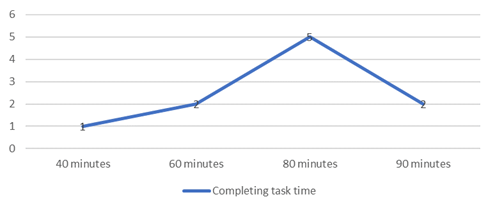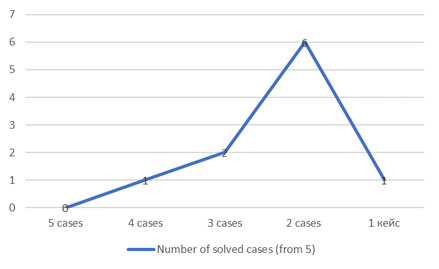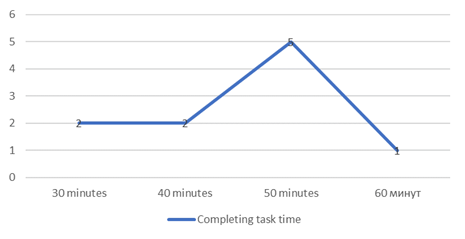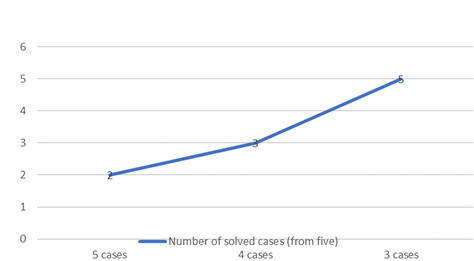Abstract
The paper is devoted to the study of the role of creative potential in the innovative development of economic systems. The authors analyse the state of knowledge of the problem of human potential in General and determines the value of creative potential as the Foundation for the development of the modern economy in particular. The article examines the essence of the phenomenon of creativity, identifies the main problems associated with the formation of creative thinking at the present stage. Thus, the authors come to the conclusion that the modern education system needs to rethink the role of creative disciplines, and, as a result, there is a need to develop such a scientific field as creative pedagogy. The paper reflects the results of the research, the hypothesis of which is the assumption that the formation of creative thinking among employees in the field of management to optimize business processes contributes to the rapid and effective solution of various business problems. In the course of the study, it was confirmed that after completing a set of creative tasks, the study participants became much more successful in solving case tasks. So, this study shows that the formation of creative potential is also appropriate for adults, since creative thinking makes it possible to continuously improve in the professional sphere. This view of the author creates a wide scope for further study of the problem, in unity and interaction with such Sciences as pedagogy, androgogy, psychology, management, art studies, cultural studies, etc.
Keywords: Human potential, the creative potential, the creative pedagogics
Introduction
Due to numerous risings and falls, the modern economy is increasingly turning its attention to the individual and its potential. And indeed, no matter what economic changes and transformations take place, no matter what subtleties of the economic world they do not affect, one thing remains constant: they all came from a person and were directed at a person. It is gratifying to note that modern economic science tends to be anthropocentric and human potential attracts more and more attention of researchers. Economics is no longer a faceless science.
Problem Statement
The modern economy needs a person who has a qualitatively new level of knowledge: a creative, mobile person who is ready to quickly respond to problems and adapt to numerous economic changes, a person who is ready to quickly adapt to new realities and competently organize the work of his team in any conditions. Today, competition in all areas is extremely high, because we live in an era of the so-called “temptation of abundance” (Semina, 2018). In addition, this issue takes on a special meaning in connection with such a problem as capital flight (Leonova, 2020).
However, a modern specialist, as a rule, acts within certain cliches and standards. This makes it difficult to be flexible in decision-making in a changing economy, which means that it can negatively affect the performance of an organization. This is largely due to the lack of preparation of most specialists for "creative, innovative activities" (Kolyadin, 2010).
The main problem of this research is the problem of the inability of the individual to fully generate innovative solutions due to the lack of creative approach.
Research Questions
The subject of this research is the creative potential of the individual in the conditions of innovative development of economic systems.
Purpose of the Study
The purpose of this study is to identify the role and means of creating creative potential as the basis for innovative development of economic systems.
The research tasks:
1) to study the role of the concept of human potential (as a more General category of creative potential) in modern research;
2) to determine the essence of creative potential as the Foundation of innovative development of economic systems.
3) to determine at what stages of the life path it is necessary to carry out the process of forming creative thinking.
Research Methods
This research includes the selection and analysis of special literature devoted to the problems of human potential, creative potential, creativity in General, and pedagogy of creativity in particular.
In addition, the study conducted an experiment that included the following stages: diagnostic, ascertaining, experimental, control, and final. Study period: 3 weeks.
Research hypothesis: the formation of creative thinking among employees in the field of management to optimize business processes contributes to the rapid and effective solution of various business problems. During the study, participants were asked to solve a number of business cases. After completing a set of creative tasks, participants were again asked to solve business cases. The results were compared and conclusions were drawn.
The most important method in this study is the generalization method, which allowed us to draw conclusions and find interconnection.
Findings
One of the most important tasks of this study is to identify at what stage the study of the problem of human potential is currently at.
First of all, it should be noted that at the moment there is no generally accepted interpretation of this concept, which indicates its complexity and versatility. In a wide range of interpretations, one can distinguish the main, general meaning of this concept, which consists in the ability of an individual (a set of individuals) to show their capabilities in practice, thereby contributing to the development of the economy.
After analyzing the literature, we found that the issue of human potential was raised back in 1998: the Nobel prize-winning Indian scientist A. Sen proposed the concept of human development. Offering an approach "from the point of view of opportunities", the researcher argued that
the development process is not only an increase in material or economic well-being, but an expansion of human capabilities, which implies greater freedom of choice, so that everyone can choose from a large number of options the goal and lifestyle that they consider preferable (Bekker, 2003, p.11).
Over the past two decades, Russian scientists have become increasingly interested in human potential. Thus, Soboleva (2007) emphasizes the importance of "realizing human potential in its labour needs" (p. 201).
Zaslavsky (2005) tries to create the wording of the concept "human potential" through the prism of the national community, namely as "the willingness and ability of the national community for active self-development, timely and adequate response to the multiple challenges of the external environment and successful competition with other companies" (p. 13).
A. G. Sukiasyan studies the human potential in synchrony and diachrony, generalizing the experience of previous decades, revealing the connection between the study of human potential and the study of the biological and sociological needs of a human being (as cited in Tikhomirova & Sukiasyan, 2013).
Thus, a wide range of scientific articles devoted to this issue, indicates that modern researchers are aware of the crucial role of human potential in the development of the economy.
In our opinion, the concept of human potential is very broad. It includes categories such as:
-abilities;
- scope;
- interests;
- aspirations.
Human potential can be viewed from a variety of points of view, respectively, it has a number of components (Kasaeva, 2013). Thus, physical health and psychological well-being are undoubtedly included in the concept of human potential. The competence of the individual is of no small importance.
However, at the present stage, the creative component plays a crucial role. The presence of all the above components without a creative approach is equivalent to a car without a steering wheel. As the practice of most business enterprises shows, solving numerous labor problems in a template way does not actually bring positive results. It is a creative, non-standard approach that is increasingly becoming the key to economic success.
According to research by Starikova et al. (2018) "employees with a rich creative vision can offer innovative solutions to traditional and new tasks" (p. 236).
The tendency of the state policy of innovative and technological development to rely on an individual who is able to "adapt quickly to changes, creatively model activities, create new approaches and solutions" is becoming more pronounced (Starikova et al., 2018).
So, the economy of knowledge and innovation is characterized by a transition from the "economic person", whose activities are aimed at optimizing results with limited resources, to the "creative person", who seeks to actively transform the world around him, the transition from the performer to the Creator. Representatives of the "creative class" differ not only in their "creative and intellectual activity, but also in their creative attitude to life" (Starikova et al., 2018, p. 236).
At this stage of development the economy is in need of a creative person. This means that modern education must face the task of educating such a person (Zinchenko & Egorov, 2019). Modern teachers should be faced with the task of transferring students from a simple, perceptual level to a truly creative, active level. They should teach not only to perceive, but also to create. This requires high pedagogical skills, which means that the pedagogy of creativity must be put on a high level.
We are facing a whole cycle of interrelated aspects: the economy depends on creative potential – creative potential depends on correctly set pedagogical tasks. So, at the root of economic transformation is the transformation of the educational process at all stages, which will allow you to form a creative personality.
First of all, let's understand the essence of the concept of creativity. Even in antiquity, this phenomenon was at the center of philosophical discussions. So, Plato pointed out the universality of this concept, in addition, the philosopher paid great attention to the act of inspiration as part of the creative process (Plato, 2018). In the Renaissance, leading artists saw the purpose of man in creative activity. Only through creativity "a person can enjoy life"(Arslanov, 2015, p. 46).
During the Modern period, the value of creativity was emphasized in numerous philosophical and artistic works. In particular, Goethe wrote: "Only creativity fills a person's life with a special meaning and allows them to enjoy life without clinging to its values"(Arslanov, 2015, p. 46). It is significant that in the concept of F. Nietzsche, creativity is the true being, it is it that creates order.
Thus, creativity has been recognized since ancient times as the highest value, the true purpose of man. Modern researchers consider this concept through the prism of its heuristic, motivational and activity components. Thus, a rather capacious definition of creativity is given by Sirotkin (2015): "Creativity is a universal quality of a person that is actualized in the course of resolving an objective and conscious contradiction, or in the course of solving a problem, overcoming difficulties (barriers), in particular, intellectual ones" (p. 82).
The modern approach to creativity should involve the active activity of the individual, the solution of tasks, its self-actualization. These aspects, in our opinion, should be the basis of the pedagogical understanding of creativity. In order to demonstrate the effect of creative activities, the author of this article conducted a small study.
Research hypothesis: the formation of creative thinking among employees in the field of management to optimize business processes contributes to the rapid and effective solution of various business problems.
A group of 10 recipients aged 25 to 40 years was invited to participate in this study. All participants work in various organizations as business process optimization managers.
The experiment was conducted at the Higher school of design and architecture of Pyatigorsk state University.
Study period: 3 weeks.
Research stages:
first stage: diagnostic.
At the first stage of the research, the author offered a selection of business cases that need to be solved using a creative approach. At the same time, the task was evaluated according to the following parameters:
- time spent on completing the task;
- number of successfully solved cases.
At this stage, the following results were obtained: For
the first parameter-the task completion time:
1 person completed the task in 40 minutes,
2 people completed the task in 60 minutes
5 people completed the task in 80 minutes
2 people completed the task in 90 minutes.
Let's present the obtained data graphically (see Figure 1):

For the second parameter-the number of successfully solved cases-the following results were obtained. In total, participants were offered 5 cases.
5 cases – 0 people;
4 cases – 1 person;
3 cases – 2 people;
2 cases – 6 people;
1 case – 1 person.
Let's present the obtained data graphically.

The second stage is the recital. At this stage, the primary results were identified. It was found that none of the study participants coped with all the proposed tasks-cases, only one person coped with four cases, three cases-2 people, two cases-6 people, and only one case was solved by one group member. The minimum time to complete cases is 40 minutes, and the maximum is 90 minutes.
The third stage: experimental. Over the course of 19 days, the participants were offered various creative tasks, including the following areas. Below is the text of some tasks:
- " Imagine that You are in a two-hour traffic jam. Compose a haiku on this occasion, observing all the requirements for haiku" (at the same time, participants are given material on the style and structure of haiku);
- "Your company's performance indicators have fallen. Devote to this event a picture in the style of abstract art".
- "Make a selection of classical music that may correspond to certain events in Your company. Justify your answer."
The fourth stage is the control stage. The participants are offered a new list of business cases that need to be solved. The tasks are identical in complexity to the previous selection proposed at the diagnostic stage.
The following results were obtained here.
For the first parameter-task completion time:
2 people completed the task in 30 minutes,
2 people completed the task in 40 minutes
5 people completed the task in 50 minutes
1 person completed the task in 60 minutes.
Let's present the obtained data graphically:

Thus, the minimum time spent on solving the case at this stage is 30 minutes, and the maximum is 60 minutes.
For the second parameter-the number of successfully solved cases-the following results were obtained. In total, at this stage, the participants were offered 5 cases.
5 cases – 2 people;
4 cases – 3 people;
3 cases – 5 people

The fifth stage: final. At this stage of the study, the results are summed up and conclusions are drawn.
It was found that the minimum time spent on solving cases after the experiment decreased from 40 to 30 minutes
The maximum execution time has also been reduced from 90 minutes to 30 minutes.
The number of solved cases has increased compared to the diagnostic stage. So, if at the diagnostic stage no one could solve five cases out of five, then at the repeated diagnostic stage two people coped with five tasks.
Three people were able to solve four cases, and five participants managed to solve three. Thus, there is a noticeable tendency to increase the efficiency of solving business problems and, consequently, optimize business processes by forming creative thinking among the study participants.
It should be noted that the authors selected only one area of human activity related to business process optimization management, but further research is needed to form a more complete scientific picture.
Conclusion
The formation of creative potential for the purpose of innovative development of economic systems must begin with the formation of creative thinking of each individual. Creative disciplines should be present at all stages of the educational process: from preschool to postgraduate education.
At the moment, there is no such approach. The course of fine arts ends in a secondary school in the 6th grade and a worthy replacement that can form creative thinking is not offered. The reason of this construction of the educational process at school age that individuals subconsciously get the wrong understanding that creativity is not for adults and in adult life it will not be useful at a time when modern society needs creative potential. In this regard, it is advisable to introduce creative disciplines into the educational process of high schools, as well as vocational schools and Universities.
This correlates with the statement of Gorbunov (2013) that a new generation University is not only fully integrated into the economy based on the transformative value of new knowledge, but also transforms it in the direction of forming a single network structure of innovative organizations that connects various sectors and spheres... (p. 55)
For the correct construction of the educational process, it is necessary to actively develop the pedagogy of creativity as a separate sphere of scientific knowledge. It is important to clearly develop a categorical apparatus, specify methods and means of forming creative thinking in accordance with age and individual characteristics of the individual. In addition, according to the research conducted by the authors, the formation of creative potential is possible and appropriate for adults, because creativity contributes to efficiency in the process of solving various labor tasks, makes it possible to improve in the professional sphere. These conclusions create a wide scope for further study of the problem in unity and interaction with such Sciences as pedagogy, androgogy, psychology, management, art studies, etc.
References
Arslanov, V. G. (2015). Teorija i istorija iskusstvoznanija. [The theory and history of art studies]. Academical project. [in Russ.].
Bekker, G. S. (2003). Chelovecheskoe povedenie: ekonomicheskij podhod [Human Behavior: an Economic Approach]. HSE. [in Russ.].
Gorbunov, A. P. (2013). Universitety v strukture ekonomiki znanija [Universities in the structure of the knowledge economy]. Terra Economicus, 11(4.3), 55-58. [in Russ.].
Kasaeva, T. V. (2013). Rasshiritelnaja traktovka struktury chelovecheskogo kapitala [Expanding definition of the human capital structure]. Terra Economicus, 11(2.2), 21-27. [in Russ.].
Kolyadin, A. P. (2010). Formy projavlenija fiktivnogo komponenta chelovecheskogo kapitala [Forms of Manifestation of The Fictitious Component of Human Capital]. Terra Economicus, 2, 7-12. [in Russ.].
Leonova, C. (2020). Faktory begstva kapitala [The Determinants of Capital Flight]. Economic journal, 2, 215-267. [in Russ.]
Plato. (2018). Dialogi. Aforizmy [Dialogues. Aphorisms]. Moscow. [in Russ.].
Semina, N. B. (2018). Iskushenie izobiliem: Homo Festivus na fone potrebitelskogo raja [Temptation by abundance: homo festivus set against a consumer paradise]. PSU [in Russ.]
Sirotkin, L. Ju. (2015). Tvorchestvo i kreativnost': vozmozhnosti ponjatijnogo kompromissa [Arts and creativity: possibilities of conceptual compromise]. Bulletin of Kazan State University of Culture and Arts, 3, 82-85. [in Russ.].
Soboleva, I. V. (2007). Chelovecheskij potencial rossijskoj jekonomiki: mehanizmy vosproizvodstva i vyzovy dlja Rossii [Human Potential of the Russian Economy: Problems of Conservation and Development]. Nauka. [in Russ.].
Starikova, M. S., Bezyglyy, E. A., & Shakhov, V. V. (2018). Kreativnyj potencial kak osnova innovacionnogo razvitija regiona [Creative potential as a basis for innovative development of the region]. BGTU. [in Russ].
Tikhomirova, T. M., & Sukiasyan, A. G. (2013). Otsenka vektora razvitiya chelovecheskogo potentsiala v subjektakh RF [On the Vector of Human Development in the Subjects of the RF]. Bulletin of the Plekhanov Russian University of Economics, 2(56), 81-91. [in Russ.].
Zaslavskaya, T. I. (2005). Chelovecheskij potencial v sovremennom transformacionnom processe. [Human Potential in the Modern Transformation Process]. Social Sciences and Modernity, 3, 5-16. [in Russ.].
Zinchenko, D. I., & Egorov, A. A. (2019). Modelirovanie effectivnosti rossiiskih universitetov [Efficiency modeling of Russian universities]. HSE Economic Journal, 23, 143-172. [in Russ.].
Copyright information

This work is licensed under a Creative Commons Attribution-NonCommercial-NoDerivatives 4.0 International License.
About this article
Publication Date
21 June 2021
Article Doi
eBook ISBN
978-1-80296-110-2
Publisher
European Publisher
Volume
111
Print ISBN (optional)
-
Edition Number
1st Edition
Pages
1-1168
Subjects
Social sciences, education and psychology, technology and education, economics and law, interdisciplinary sciences
Cite this article as:
Rubets, E. A., Golubich, S. A., Gladskih, A. I., Dmitrienko, B. C., & Kovaleva, O. A. (2021). Creative Potential In The Innovative Development Of Economic Systems. In N. G. Bogachenko (Ed.), Amurcon 2020: International Scientific Conference, vol 111. European Proceedings of Social and Behavioural Sciences (pp. 815-823). European Publisher. https://doi.org/10.15405/epsbs.2021.06.03.108

